Teaching The Greedy Triangle
 All Classroom Lessons
All Classroom Lessons
A Lesson for First and Second Grade

by Lynn Sherman
Lynn Sherman is a teacher candidate at York University in Toronto, Ontario, where she recently taught a geometry class based on The Greedy Triangle, by Marilyn Burns (Scholastic, 1994), to a class of second graders. She gave the story an added dimension with the creation of her Greedy Triangle “prop.” We’re sure other teachers will benefit from her creative idea!
In The Greedy Triangle, the Triangle character is dissatisfied with its shape and decides, through the help of the Shapeshifter, to take on some new identities. By continuing to add one more side to itself, it changes from a triangle, to a quadrilateral, to a pentagon, and more. I wanted to read the book aloud to my second graders during a geometry class, but I wasn’t sure they would understand the concept of the Triangle adding “another side.” To prepare for the lesson, I decided to make a prop so that the children would see what it meant for the Triangle to add another side.
For the prop I used eight strips of cardboard. (Teachers can add as many strips as they like; however, I wanted to go only as far as an octagon.) The strips were approximately 6 inches long by 1 inch wide. I punched a hole at each end of the strips and, with seven fasteners, strung the eight strips together, end-to-end. The prop folds up like an accordion and opens up when one pulls up each individual strip.

When I read the book aloud to my students, I started out making a triangle, as that’s the first shape in the book. By pulling up one more strip, I made the prop into a quadrilateral, the next shape in the book. I continued on using the prop as I read aloud the book, turning the prop into a pentagon, a hexagon, a heptagon, an octagon, and then back into a triangle. It was like magic! The students were able to see the shape change from one form into another right before their eyes.
The prop has also proved useful for making asymmetrical shapes in other lessons. I think other primary teachers will find this easy-to-make prop a nice visual complement when teaching The Greedy Triangle.
featured in Math Solutions Online Newsletter, Spring 2008, Issue 29

Comments